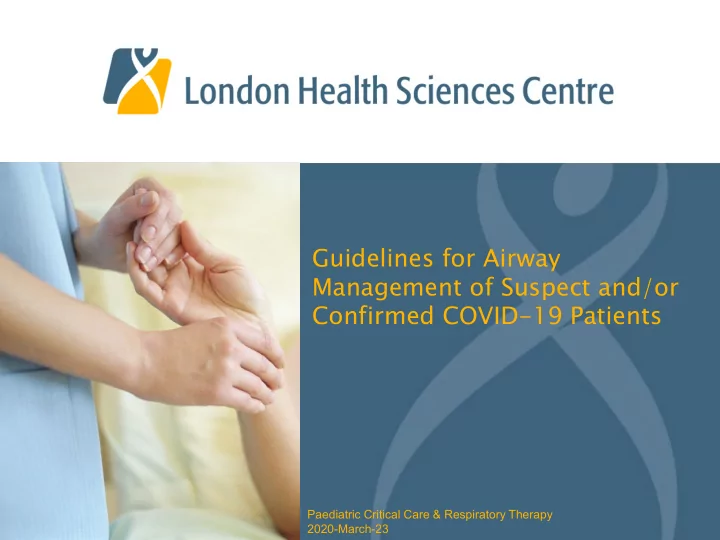

Guidelines for Airway Management of Suspect and/or Confirmed COVID-19 Patients Paediatric Critical Care & Respiratory Therapy 2020-March-23
Paediat diatri ric Pati tient with th AR ARI Manage with low flow If unable to keep Sat > 90 Give higher conc via highox (if available) Still not acceptable sat, use NIV HFNC, CPAP, BiPAP, (in negative pressure under D+C+E* Unsatisfactory Sat, intubate and ventilate * Droplet + Contact + Enhanced Protection 3/26/2020 1 2020-March-23 1 3/26/2020 Obtained on March 23, 2020 Created By: Children’s Hospital, Paediatric Critical Care & Respiratory Therapy
Paedia iatric ric Patient with h Respiratory Illne ness Requi uiring ng Interve ventio ion/Ho Hospit itali lizatio ion 1. Appropriate droplet/contact precautions for HCP and patient 2. Early sample for 2019-nCoV (if specimen sent to PH at referring site, re-do at LHSC) 2019-nCoV POSTIV IVE 2019-nCoV NEGATIVE or or - Avoid aerosolizing not m meeti ting ng c crite teri ria f for r 2019-nCoV UNKNOWN, procedure, perform under testi ting ng bu but po potential P PUI airborne/droplet precautions if needed Also see Al ee n nex ext p page TREAT AT A AS U USUAL AL - Avoid excess fluid D+C P Precautions administration Principle: avoidance of AGMP is possible until 2019-nCoV result available, due to risk to staff and need for airborne isolation - Consider risk factors for likely 2019-nCoV (presenting features, level or exposure) - If hypoxic: apply standard LF02 protocol via nasal prongs, face mask, NRB) early transfer to PCCU - If ongoing concerns requiring resp support, not adequately improving with LF02: particularly 1. Hig igh ris risk g gro roups: Extreme Prems, paediatric patients with asthma/croup, complex care paediatric patients who if intubated would be challenging to extubate/ventilate and may require only transient need for HF02/CPAP/BIPAP can be put on these AGMPs (in airborne isolation if possible). 2. Some rapidly deteriorating patients may require early intubation. 2 3/26/2020 2020-March-23 2 3/26/2020 Obtained on March 23, 2020 Created By: Children’s Hospital, Paediatric Critical Care & Respiratory Therapy
Paediatric Patient with Infection related Respiratory Distress Recog ogniti tion on & 2019 2019-nCoV UN UNKN KNOWN Asthma Presentation Croup Presentation LRTI (wheeze, diminished Assessm Asse ssment (stridor, barking (cough, crackles, fever, AE, prolonged cough) hypoxia, tachypnea) expiration) 1. Salbutamol MDI 1. Antibiotics as w/spacer indicated 2. + Systemic 1. *Nebulized 2. Avoid excess fluids Steroids 3. Avoid ACMP’s, but Epinephrine in 3. +/- Magnesium Man anag agement airborne precautions if needed perform Sulfate under airborne 2. Dexamethasone 4. IV salbutamol if precautions MDI ineffective ( If failed, may need NIV under enhanced precautions) 3 3/26/2020 2020-March-23 3 3/26/2020 Obtained on March 23, 2020 Created By: Children’s Hospital, Paediatric Critical Care & Respiratory Therapy
Step teps in intu tubtion on Utilize an observer to assist with donning of PPE if not familiar with procedure 1) Don appropriate PPE (See Appendix B) 2) Provide five minutes of preoxygenation with oxygen 100% (via non-rebreather mask) to 3) avoid manual ventilation The most experienced HCW should attempt the intubation to maximize chances of first pass 4) success Utilize rapid sequence induction (RSI) when possible 5) Utilize video assisted intubation when possible 6) Avoid awake intubation and use of atomized anesthetic 7) Avoid Manual ventilation. If necessary, small tidal volumes should be applied 8) Ensure high efficiency hydrophobic filter interposed between facemask and breathing circuit 9) or between facemask and Ambu bag (see Appendix C for diagram) Post intubation auscultation and ventilation should only initiate once endotracheal balloon 10) has been inflated If intubation fails, either insert LMA, ventilate with bag-valve-mask (BVM) with filter attached 11) (see Appendix C for diagram) OR Consider 2 person BVM with PERSON #1 dedicated to proper positioning of the airway while ensuring seal of mask and PERSON #2 bagging with low volume breaths Practice appropriate hand hygiene after procedure and in the process of doffing PPE (See 12) Appendix B) Utilize an observer to assist with doffing of PPE if not familiar with procedure 13) 4 4 3/26/2020 Obtained on March 23, 2020 Created By: Children’s Hospital, Paediatric Critical Care & Respiratory Therapy
Recommend
More recommend